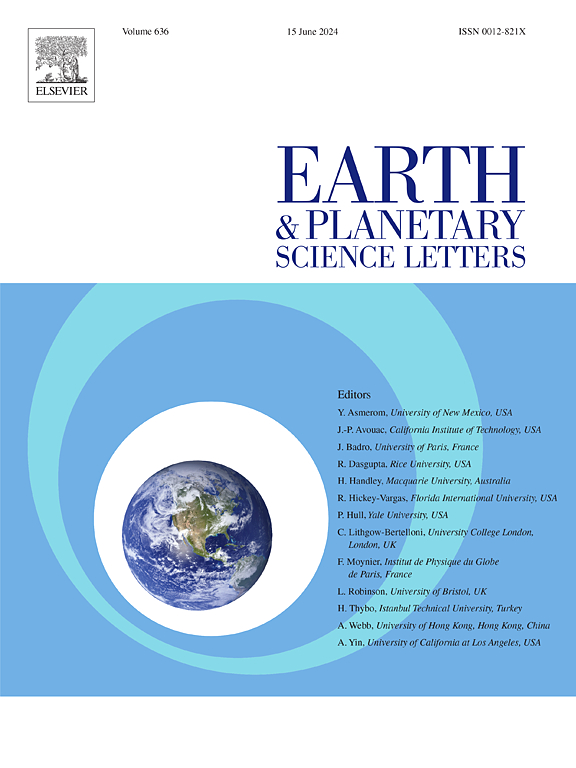碳质软玉运抵地球的机制和时间
IF 4.8
1区 地球科学
Q1 GEOCHEMISTRY & GEOPHYSICS
引用次数: 0
摘要
陨石和大块硅酸盐地球(BSE)的核合成同位素特征表明,地球由 "碳质"(CC)和 "非碳质"(NC)物质混合组成。我们的研究表明,BSE 的同位素组成中记录的 CC 物质的比例因不同元素而异,并取决于该元素分化为金属的倾向及其挥发性。观察到的行为表明,地球吸积的大部分物质以NC为主,但以CC为主的物质在地球吸积的最后∼2-10%期间富含中度挥发性元素,富集系数为∼10。CC物质很晚才被输送到地球,这与巨行星生长和迁移过程中CC物体很早就被植入内太阳系的动力学证据形成了鲜明对比。这一点,再加上地球晚期的贴面和火星主体都以NC为主的性质,表明向内散布的物质的大部分质量都集中在少数大型CC胚胎中,而不是较小的行星碎片中。我们提出,地球吸积了其中几个 CC 胚胎,而火星没有,至少有一个 CC 胚胎在相对较晚的时候(吸积完成 90-98% 时)撞击了地球。只要这种撞击没有使整个地球的地幔重新同质化,那么这种情况就与随后一个大型NC天体撞击月球形成的情况是一致的。本文章由计算机程序翻译,如有差异,请以英文原文为准。
Mechanisms and timing of carbonaceous chondrite delivery to the Earth
The nucleosynthetic isotope signatures of meteorites and the bulk silicate Earth (BSE) indicate that Earth consists of a mixture of “carbonaceous” (CC) and “non-carbonaceous” (NC) materials. We show that the fraction of CC material recorded in the isotopic composition of the BSE varies for different elements, and depends on the element's tendency to partition into metal and its volatility. The observed behavior indicates that the majority of material accreted to the Earth was NC-dominated, but that CC-dominated material enriched in moderately volatile elements by a factor of ∼10 was delivered during the last ∼2–10% of Earth's accretion. The late delivery of CC material to Earth contrasts with dynamical evidence for the early implantation of CC objects into the inner solar system during the growth and migration of the giant planets. This, together with the NC-dominated nature of both Earth's late veneer and bulk Mars, suggests that material scattered inwards had the bulk of its mass concentrated in a few, large CC embryos rather than in smaller planetesimals. We propose that Earth accreted a few of these CC embryos while Mars did not, and that at least one of the CC embryos impacted Earth relatively late (when accretion was 90–98% complete). This scenario is consistent with the subsequent Moon-forming impact of a large NC body, as long as this impact did not re-homogenize the entire Earth's mantle.
求助全文
通过发布文献求助,成功后即可免费获取论文全文。
去求助
来源期刊

Earth and Planetary Science Letters
地学-地球化学与地球物理
CiteScore
10.30
自引率
5.70%
发文量
475
审稿时长
2.8 months
期刊介绍:
Earth and Planetary Science Letters (EPSL) is a leading journal for researchers across the entire Earth and planetary sciences community. It publishes concise, exciting, high-impact articles ("Letters") of broad interest. Its focus is on physical and chemical processes, the evolution and general properties of the Earth and planets - from their deep interiors to their atmospheres. EPSL also includes a Frontiers section, featuring invited high-profile synthesis articles by leading experts on timely topics to bring cutting-edge research to the wider community.
 求助内容:
求助内容: 应助结果提醒方式:
应助结果提醒方式:


